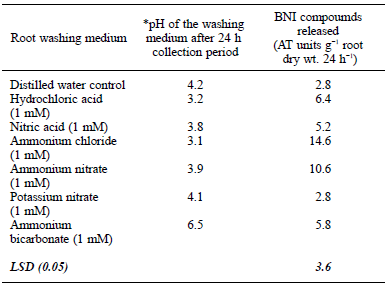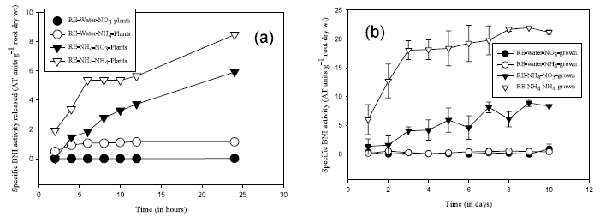NH4 + triggers the synthesis and release of biological nitrification inhibition compounds in the tropical grass Brachiaria humidicola
Description
The phenomenon of plants releasing inhibitory compounds from their roots that suppress nitrifying bacterial activity in soil, and thus nitrification, is termed biological nitrification inhibition (BNI). This phenomenon has been demonstrated in Brachiaria humidicola, a tropical grass grown extensively in South America. Our earlier studies have indicated that the release of these inhibitors from roots is a highly regulated plant attribute. During this investigation, we have tested a hypothesis that the presence of NH4+ in the rhizosphere is necessary for the release of BNI activity from the roots, assuming that BNI activity is released from the roots to specifically protect NH4+ from nitrification.
In Experiment 1, plants were grown for 60 days in solution culture (Fig. 1) with NH4+ as the nitrogen source. The root exudate was collected from intact plant roots using treatment solutions that included the presence of NO3-, NH4+, or low pH (such as 1 mM HCl or HNO3) (Table 1). This was to test the hypothesis that release of BNI activity is stimulated by the presence of NH4+ or due to the secondary effect of low pH caused by the uptake of NH4+. The results indicated that release of BNI activity was triggered by the synergistic effects of the presence of NH4+ and the acidity caused by NH4+ uptake; this was evident from the several-fold increase in BNI activity from the roots when root exudate was collected using either NH4Cl or NH4NO3 solutions (where the pH of the root exudate solution became acidic, ranging from 3 to 4 after a 24 h collection period) (Table 1). Acidic pH alone (i.e., treatment solutions of 1 mM HNO3 or HCl) or the presence of NH4+ in the collection solution alone (i.e., without acidic pH followed by NH4+ uptake: this was achieved by NH4HCO3 solution treatment) did not have a substantial impact on BNI release from roots.
In a follow-up experiment, BNI activity release was monitored in the presence or absence of NH4+ in the root exudate collection solution (from NH4+ and NO3--supplied plants) at 2 h intervals for a 24 h period and at 24 h sampling intervals over a 10-day period. The release of BNI activity in the presence of NH4+ was several-fold higher than in the absence of NH4+ (i.e., in the root exudate collection solutions) (Fig. 2a) from both NH4+ and NO3--supplied plants; however, BNI activity release was substantially higher from NH4+-supplied than from NO3--supplied plants. The release of BNI activity was maintained during the 10-day monitoring period in the presence of NH4+ (Fig. 2b), demonstrating the importance of the presence of NH4+ in the rhizosphere for the release of BNI from roots.
Our results demonstrate that BNI release from roots in B. humidicola is triggered and regulated by the presence of NH4+ in the rhizosphere, thus establishing a functional link between BNI release and protection of NH4+ from nitrifiers. These results have wide-ranging implications for the genetic exploitation of BNI attributes in pastures and, in particular, the isolation of genes involved in the synthesis and release of BNI activity from B. humidicola roots.
Figure, table
-
Fig. 1.
About 60-day-old B. humidicola grown in nutrient solutions were used for collecting root exudates using various treatment solutions. -
Table 1.
Influence of root washing medium on the release of BNI compounds from roots. -
Fig. 2.
Release of BNI compounds in the presence and absence of NH4+ in the root washing medium during a 24 h collection period [2 h intervals (a)] and a 10-day collection period [24 h intervals (b)]. -
- Affiliation
-
Japan International Research Center for Agricultural Sciences Crop Production and Environment Division
- Classification
-
Technical A
- Term of research
-
FY2006(FY2006~2011)
- Responsible researcher
-
SUBBARAO Guntur Venkata ( Biological Resources Division )
ITO Osamu ( Biological Resources Division )
- ほか
- Publication, etc.
-
Subbarao, G.V., Ito, O., Sahrawat, K.L., Berry, W.L., Nakahara, K., Ishikawa, T., Watanabe, T., Suenaga, K., Rondon, M., and Rao, I.M. 2006. Scope and Strategies for Regulation of Nitrification in Agricultural Systems - Challenges and Opportunities. Critical Reviews in Plant Sciences, 25:303-335.
https://doi.org/10.1007/s11104-006-9156-6.Subbarao, G.V., Wang, H.Y., Ito, O., Nakahara, K., and Berry, W.L. 2006. NH4+ triggers the synthesis and release of biological nitrification inhibition compounds in Brachiaria humidicola roots. Plant Soil.
- Japanese PDF
-
2006_seikajouhou_A4_ja_Part12.pdf706.08 KB




